|
About
the work of the years 1961-65
and the 18 x 18 in. collages
(Written March 17,
2003 or before)
There was a goal to my
work I did not know; there was an image there I did not see.
The goal was my growth
from the sailor to the good husbandman, and the image I did not see was
the picture of that process. I did not know the goal no matter how
ardently it was desired because I knew only what I was that I did not want
to be; I did not know what it was I would become. I knew I would die
in the polymorphous ocean of a sailor’s lust burning in my blood; I did
not know that the fields and orchards of the Sonoma of my childhood would
be the aurum nostrum to tell me how to live.
Teleology is the
study—the knowledge—of the growth of forms in time from their origin until
their extinction. I think now my paintings 1961-65 show the
teleology of the forms of my life as I became a husband and father, a
householder and a man.
The alchemist looked into
the alembic; I looked into a square of paper on the studio table.
Our methods differed but our goal was the same. Out of the
nigredo that is the true source of all my life never to be denied and
forever praised as origin and food for every day, my goal
like the
alchemist’s was to create the aurum nostrum that is the end never
to be found because the seeking is the finding.
There remain many, many
paintings from the 1961-65 time. To select some few and not some
other few as markers of the path I took, to select some studio notes and
not others as the story of the journey, is only to say that every painting
was marker of the path, every note a sentence in the story of my journey
to manhood.
*
May 26, 2003.
We believed then with all
our hearts that our purpose as artists was to make a mark in history, to
advance the tradition of painting by revolutionary action—to be avant
garde, that was to live. And so I made these collages in that
belief and with that belief I justified my life as an artist… and as a
human being of value. That this work did not initiate a “school”
like Picasso’s cubism did, I noticed but did not allow to deter me.
Nor did it lead to a questioning of the core belief—the “lie of life”*—of
modernism as it was understood by everyone in the art world. I
thought only, that I should try harder.
____________________
* “The lie of life” is an idea I picked up
from late 19th century readings, the idea that the core belief
one has about oneself that justifies one’s life is a lie, a delusion, and
when one realizes that belief to be a lie, the only answer is spiritual or
physical suicide.
Whenever challenges arose
about my belief in the revolutionary value of myself and my work, I would
write whining paragraphs of self pity in my studio notes, and would make
collages ever more contrary-wise to what the art world was doing,
insisting to myself and to anyone who looked at the work that the very
contrariness of the work was the proof that I was, indeed, more avant
garde and so more valuable to history than anyone else.
Forty years later, I
still think that. However, the out-of-stepness of this 1961-65
work—the difference that is its contribution to the history of art—is not
in my delusions of avant garde (you aren’t avant garde if
the army does not follow). Rather, what contribution the work makes
to the history of art is to show that if your psyche demands to grow, art
can be a tool.
And so the contribution
these works make is not to the tradition of painting, but to the
traditions of ways of being a human being—and an artist. The works,
and I, are not avant garde. Merely, in our way, perennial. |
.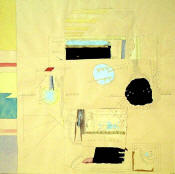
1. Now Voyager.
1963
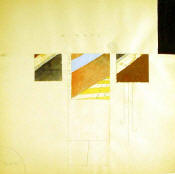
3. Time Is Then, Now, Always.
1963
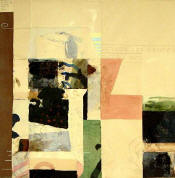
Vernon Lee, Antica Ostia, 1902.
1964
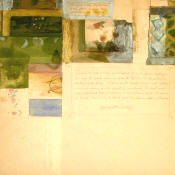
5. The Fruit Is Only by the Touch.
1964
|
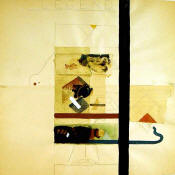
2. Legend of Man and Woman.
1963
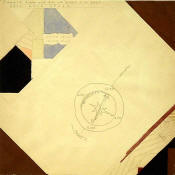 4.
Red Sails in The Sunset, or Flowers Bloom and Die, 4.
Red Sails in The Sunset, or Flowers Bloom and Die,
Love Stays.
1964
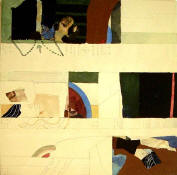
Over the Hills and Far Away.
1964.

6. A Budding Branch.
1964 |